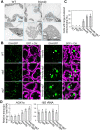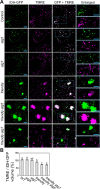Autophagy Contributes to the Quality Control of Leaf Mitochondria
- PMID: 33355344
- PMCID: PMC8112837
- DOI: 10.1093/pcp/pcaa162
Autophagy Contributes to the Quality Control of Leaf Mitochondria
Abstract
In autophagy, cytoplasmic components of eukaryotic cells are transported to lysosomes or the vacuole for degradation. Autophagy is involved in plant tolerance to the photooxidative stress caused by ultraviolet B (UVB) radiation, but its roles in plant adaptation to UVB damage have not been fully elucidated. Here, we characterized organellar behavior in UVB-damaged Arabidopsis (Arabidopsis thaliana) leaves and observed the occurrence of autophagic elimination of dysfunctional mitochondria, a process termed mitophagy. Notably, Arabidopsis plants blocked in autophagy displayed increased leaf chlorosis after a 1-h UVB exposure compared to wild-type plants. We visualized autophagosomes by labeling with a fluorescent protein-tagged autophagosome marker, AUTOPHAGY8 (ATG8), and found that a 1-h UVB treatment led to increased formation of autophagosomes and the active transport of mitochondria into the central vacuole. In atg mutant plants, the mitochondrial population increased in UVB-damaged leaves due to the cytoplasmic accumulation of fragmented, depolarized mitochondria. Furthermore, we observed that autophagy was involved in the removal of depolarized mitochondria when mitochondrial function was disrupted by mutation of the FRIENDLY gene, which is required for proper mitochondrial distribution. Therefore, autophagy of mitochondria functions in response to mitochondrion-specific dysfunction as well as UVB damage. Together, these results indicate that autophagy is centrally involved in mitochondrial quality control in Arabidopsis leaves.
Keywords: Arabidopsis (Arabidopsis thaliana); Autophagy; Mitochondria; Mitophagy; Organelle quality control; Ultraviolet B.
� The Author(s) 2020. Published by Oxford University Press on behalf of Japanese Society of Plant Physiologists.
Figures









Comment in
-
Mitophagy-A New Player in UV-B Damage Recovery in Plants.Plant Cell Physiol. 2021 May 11;62(2):226-228. doi: 10.1093/pcp/pcab012. Plant Cell Physiol. 2021. PMID: 33515260 No abstract available.
Similar articles
-
Autophagy-deficient Arabidopsis mutant atg5, which shows ultraviolet-B sensitivity, cannot remove ultraviolet-B-induced fragmented mitochondria.Photochem Photobiol Sci. 2020 Dec 1;19(12):1717-1729. doi: 10.1039/c9pp00479c. Epub 2020 Nov 25. Photochem Photobiol Sci. 2020. PMID: 33237047
-
AUTOPHAGY-RELATED11 plays a critical role in general autophagy- and senescence-induced mitophagy in Arabidopsis.Plant Cell. 2014 Feb;26(2):788-807. doi: 10.1105/tpc.113.120014. Epub 2014 Feb 21. Plant Cell. 2014. PMID: 24563201 Free PMC article.
-
Friendly mediates membrane depolarization-induced mitophagy in Arabidopsis.Curr Biol. 2021 May 10;31(9):1931-1944.e4. doi: 10.1016/j.cub.2021.02.034. Epub 2021 Mar 11. Curr Biol. 2021. PMID: 33711250
-
Oxidative stress-induced autophagy in plants: the role of mitochondria.Plant Physiol Biochem. 2012 Oct;59:11-9. doi: 10.1016/j.plaphy.2012.02.013. Epub 2012 Feb 16. Plant Physiol Biochem. 2012. PMID: 22386760 Review.
-
Lysosomal degradation of depolarized mitochondria is rate-limiting in OPTN-dependent neuronal mitophagy.Autophagy. 2020 May;16(5):962-964. doi: 10.1080/15548627.2020.1734330. Epub 2020 Mar 4. Autophagy. 2020. PMID: 32131674 Free PMC article. Review.
Cited by
-
Proteomics revealed novel functions and drought tolerance of Arabidopsis thaliana protein kinase ATG1.BMC Biol. 2025 Feb 21;23(1):48. doi: 10.1186/s12915-025-02149-3. BMC Biol. 2025. PMID: 39984923 Free PMC article.
-
The core autophagy machinery is not required for chloroplast singlet oxygen-mediated cell death in the Arabidopsis thaliana plastid ferrochelatase two mutant.BMC Plant Biol. 2021 Jul 19;21(1):342. doi: 10.1186/s12870-021-03119-x. BMC Plant Biol. 2021. PMID: 34281507 Free PMC article.
-
Carbon starvation, senescence and specific mitochondrial stresses, but not nitrogen starvation and general stresses, are major triggers for mitophagy in Arabidopsis.Autophagy. 2022 Dec;18(12):2894-2912. doi: 10.1080/15548627.2022.2054039. Epub 2022 Apr 3. Autophagy. 2022. PMID: 35311445 Free PMC article.
-
Autophagic degradation of membrane-bound organelles in plants.Biosci Rep. 2023 Jan 31;43(1):BSR20221204. doi: 10.1042/BSR20221204. Biosci Rep. 2023. PMID: 36562332 Free PMC article. Review.
-
How Lipids Contribute to Autophagosome Biogenesis, a Critical Process in Plant Responses to Stresses.Cells. 2021 May 21;10(6):1272. doi: 10.3390/cells10061272. Cells. 2021. PMID: 34063958 Free PMC article. Review.
References
-
- Boesch P., Weber-Lotfi F., Ibrahim N., Tarasenko V., Cosset A., Paulus F., et al. (2011) DNA repair in organelles: pathways, organization, regulation, relevance in disease and aging. Biochim. Biophys. Acta 1813: 186–200. - PubMed
-
- Chung T., Phillips A.R., Vierstra R.D. (2010) ATG8 lipidation and ATG8-mediated autophagy in Arabidopsis require ATG12 expressed from the differentially controlled ATG12A AND ATG12B loci. Plant J. 62: 483–493. - PubMed
-
- Clausen C., Ilkavets I., Thomson R., Philippar K., Vojta A., M�Hlmann T., et al. (2004) Intracellular localization of VDAC proteins in plants. Planta 220: 30–37. - PubMed
MeSH terms
LinkOut - more resources
Full Text Sources

